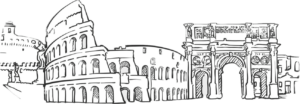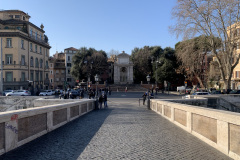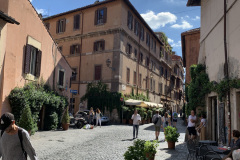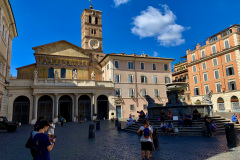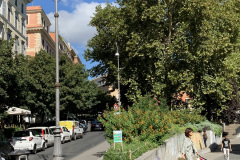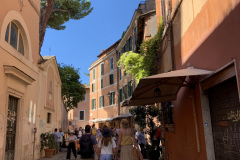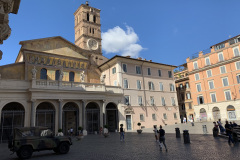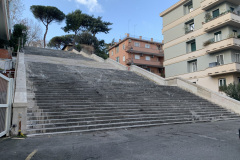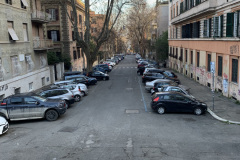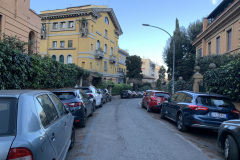Trastevere is very cosy and original, colourful and always alive. It is the core of the night life and of food and wine. Walking along the narrow streets, you can find trattorie, markets, small shops and handycrafts workshops. Trastever is a concentration of monuments and churches that contain works of art of great value; it includes wonderful squares such as Piazza Trilussa, Piazza Santa Maria in Trastevere and Piazza San Cosimato.
As a matter of fact Trastevere is one of the oldest areas of the city and has been shaped over time starting from the Ancient Rome, passing through the Middle Ages, the Rome of the Popes and of the Risorgimento up to our times.
At the time of Rome's foundation, the Trastevere area was a hostile land belonging to the Etruscans of Veio (litus tuscus or ripa veiens). The territory was disputed with the newly founded city because it was strategic for the control of the river, the ford of the Tiber Island and the ancient river port. It was then connected with the rest of the city by the pons Sublicius, from which the via Campana started towards the salt pans on the Tyrrhenian Sea and later the via Aurelia towards the Etruscan cities.
At the time of the founding of Rome, Trastevere was a hostile land that belonged to the Etruscans.
In the Republican age it was populated by groups of people very different from each other, but whose activities were linked to the river, such as sailors and fishermen, but also oriental immigrants, mainly Jews and Syrians.
Trastevere officially became part of the city when the Emperor Augustus divided the territory of Rome into 14 regions of which Trastevere was the fourteenth and was called "regio transtiberim".
Although Trastevere was part of the Capital of the Roman Empire, it maintained a rural character and for this reason, during the imperial time, many VIPs decided to build their villas in Trastevere. An example of this is that of Julius Caesar (Orti di Cesare).
During the Middle Ages Trastevere was a labyrinth of irregular and winding narrow lanes. The area was then inaccessible to the passage of wagons due to the presence of “mignani” protruding blocks along the facades of the houses. The “mignani” were demolished at the end of the fifteenth century but, despite this, the dense intrigue of alleys remained, creating a strong contrast between the rich and opulent homes of the lords and the huts of the poorest people. During this time, religious complexes such as San Cosimato and churches with characteristic Romanesque bell towers were built or rebuilt.
Even the streets were paved only at the end of the fifteenth century thanks to the will of Pope Sixtus IV, who had some streets paved, first with herringbone bricks, then with cobblestones, more suitable for carriage wheels.
In 1744 Pope Benedict XIV made a revision of the delimitation of the districts, giving Trastevere its current boundaries.
When Rome became the capital of the Kingdom of Italy at the end of the 1800s, the Janiculum promenade, the Palatine, Garibaldi and Mazzini bridges and the monumental Ministry of Education were opened. The Walls and the Lungotevere were also built to protect from floods. The walls certainly brought greater security and a more monumental aspect, but unfortunately the most characteristic places on the river bank were destroyed
Thanks to its partial isolation beyond the Tiber and the multicultural environment since the time of ancient Rome, the inhabitants of Trastevere, called “Trasteverini”, came to form almost a population of their own: commoners of known tenacity, pride and genuineness. Furthermore, women were considered very beautiful, with very dark eyes and hair, and also beautiful features.
One of the most famous Italian actors, Alberto Sordi, was born in the Trastevere district. In addition, the famous director Sergio Leone spent his childhood and youth years at the foot of the stairway that descends from the Janiculum towards Trastevere. A plaque with a quote from him is posted on the building where he lived: "My way of seeing things is sometimes naive, a little childish, but sincere. Like the children on the steps of Viale Glorioso".
Walking through the many alleys of this Area is an experience that never disappoints. In addition, from Trastevere you can reach, on foot or by public transport, many other characteristic areas of Rome such as: Largo Argentina, Il Ghetto, Tiberina Island, Janiculum Hill and the Fontana dell'Acqua Paola called "il Fontanone", Botanical Garden, Circus Maximus and many others.
